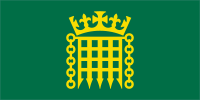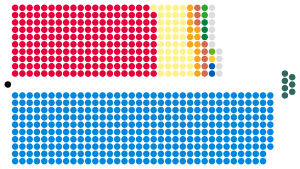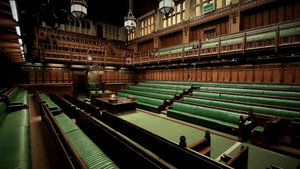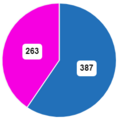House of Commons of the United Kingdom facts for kids
Quick facts for kids House of Commons |
|
|---|---|
| 59th Parliament of the United Kingdom | |

Logo of the House of Commons
|
|

Flag of the House of Commons
|
|
| Type | |
| Type | |
| Leadership | |
|
Sir Lindsay Hoyle
Since 4 November 2019 |
|
|
Chairman of Ways and Means
|
Nus Ghani, Conservative
Since 23 July 2024 |
|
Sir Keir Starmer, Labour
Since 5 July 2024 |
|
|
Leader of the House
|
Lucy Powell, Labour
Since 5 July 2024 |
|
Government Chief Whip
|
Sir Alan Campbell, Labour
Since 5 July 2024 |
|
Kemi Badenoch, Conservative
Since 2 November 2024 |
|
|
Jesse Norman, Conservative
Since 5 November 2024 |
|
| Structure | |
| Seats | 650 |
 |
|
|
Political groups
|
HM Government
|
|
Length of term
|
Up to five years |
| Elections | |
| First-past-the-post | |
|
Last election
|
4 July 2024 |
|
Next election
|
On or before 15 August 2029 |
| Redistricting | Every eight years, proposed by the boundary commissions |
| Meeting place | |
 |
|
| House of Commons chamber Palace of Westminster City of Westminster London, England United Kingdom |
|
The House of Commons is an important part of the Parliament of the United Kingdom. It's like the main team that helps run the country. It meets in the Palace of Westminster in London, just like the House of Lords, which is the other part of Parliament.
The House of Commons has 650 members. These members are called Members of Parliament (MPs). People in different areas of the UK vote for their MP. They use a system called "first-past-the-post," where the person with the most votes wins. MPs keep their jobs until Parliament is ended, usually for a new election.
Contents
What the House of Commons Does
Working with the Government
The House of Commons doesn't officially pick the Prime Minister. But, the Prime Minister must have the support of most MPs in the House. This means the political parties in the House are very important.
When a Prime Minister leaves office, the King or Queen chooses someone who has the most support. This is usually the leader of the biggest party. The leader of the second-biggest party becomes the Leader of the Opposition.
MPs can show they don't support the government. They do this by voting on a "motion of confidence" or "no confidence." If the government loses this vote, the Prime Minister usually resigns. Or, they might ask the King or Queen to call a new election.
Parliament can last up to five years. However, Prime Ministers can ask for an earlier election. This is a return to how things worked before 2011. Many Prime Ministers have taken office after another Prime Minister from their own party resigned.
Ministers and the House
Ministers, who are in charge of government departments, are usually MPs or members of the House of Lords. Most important government jobs are held by MPs from the House of Commons. This is because MPs are elected by the public. This means they are directly responsible to the people.
The Prime Minister chooses who becomes a minister. The King or Queen formally approves these choices.
Checking on the Government
The House of Commons checks what the government is doing. They do this through special committees and during "Prime Minister's Questions." This is when MPs ask the Prime Minister questions. Other ministers also answer questions at different times.
Prime Minister's Questions happens every Wednesday for about 30 minutes. Questions must be about the minister's official work. MPs from the government party and opposition parties take turns asking questions. MPs can also ask questions in writing.
Sometimes, it can be hard for MPs to fully check the government. This is because the ruling party often has a large number of MPs. This means they don't always need to agree with other parties.
Major political parties usually expect their MPs to vote in a certain way. Many MPs from the ruling party are also paid government members. However, MPs can sometimes go against their party's wishes. This can force the government to change its plans. Special committees also do a good job of checking the government's work.
The House of Commons can also accuse ministers of crimes. This is called "impeachment." The House of Lords then decides if they are guilty. This power is rarely used now. The last time was in 1806.
Making Laws
New laws, called "bills," can start in either the Commons or the Lords. But important bills usually start in the House of Commons. The Commons has more power in making laws. This is because of laws passed in 1911 and 1949.
The House of Lords cannot delay bills about taxes or public money for more than one month. For most other bills, they can only delay them for up to two parliamentary sessions (about one year). These rules apply to bills that start in the Commons.
Only the House of Commons can start bills about taxes or government spending. The House of Lords cannot change these bills. Because of these rules, the House of Commons is clearly the more powerful part of Parliament.
History of the Commons
How the Commons Began
Today's British Parliament comes mostly from the Parliament of England. In 1707, England and Scotland joined together. This created a new Parliament of Great Britain. It added 45 MPs from Scotland. Then, in 1801, Great Britain and Ireland joined. This added 100 Irish members to the Commons. It became the Parliament of the United Kingdom.
The word "commons" comes from an old word meaning "of the people" or "the community." It referred to the ordinary people, not the nobles. This is why the House of Commons represents the people.
Room Design
The way the Commons chamber looks today is based on an old chapel. This chapel was called St. Stephen's Chapel. It was used by the House of Commons for a long time.
The room is rectangular, like the chapel. The benches face each other, just like the choir stalls in a chapel. This setup helps create a lively debate.
The distance between the government and opposition benches is about 4 meters (13 feet). People say this is the length of two swords. This is a symbol, as weapons have been banned in the chamber for hundreds of years.
Changes in the 1800s
The House of Commons changed a lot in the 1800s. Before this, some towns that were no longer important still had MPs. These were called "rotten boroughs." For example, Old Sarum had only six voters but two MPs! At the same time, big cities like Manchester had no MPs of their own.
Wealthy landowners also controlled "pocket boroughs." They could choose who became the MP.
In 1832, the "Great Reform Act" was passed. This law got rid of the rotten boroughs. It also gave more people the right to vote and gave MPs to growing cities. After this, the House of Commons became more powerful. It was accepted that the government needed the support of the Commons to stay in power.
More reforms happened later in the 1800s. Laws in 1867 and 1884 gave even more people the right to vote. In 1885, most areas started electing only one MP.
The 1900s and Beyond
In 1911, a law called the Parliament Act was passed. This law greatly reduced the power of the House of Lords. The Lords could only delay most laws, not stop them. This made the House of Commons the most powerful part of Parliament.
Before 1911, only government ministers were paid. Most other MPs had their own money or were supported by rich people. In 1911, MPs started getting salaries.
In 1918, women over 30 who owned property could vote. Men over 21 could also vote, even if they didn't own property. Soon after, women could also become MPs. The first woman MP was Constance Markievicz. She was from Ireland but never took her seat in Westminster. In 1928, women got the same voting rights as men.
Recent Changes
In 2009, there was a big scandal about MPs' expense claims. This made the public lose trust in MPs. It also led to the Speaker of the House resigning for the first time in 300 years.
In 2011, people voted in a referendum. They were asked if they wanted to change the voting system. The idea was rejected by most voters.
A law passed in 2011, the Fixed-term Parliaments Act, changed how elections were called. It gave Parliament the power to call an early election, not just the Prime Minister. This law was used in 2017 for an early election. However, this Act was repealed in 2022. Now, the Prime Minister can again ask the King or Queen to dissolve Parliament and call an election.
In 2015, the Recall of MPs Act was passed. This law allows voters to remove an MP if they have done something wrong. If enough people sign a petition, the MP loses their seat, and a new election is held.
During the COVID-19 pandemic in 2020, new ways of meeting were introduced. MPs could attend debates remotely using video calls. This allowed fewer MPs to be in the chamber at one time. These special rules ended in 2021.
MPs and Elections
Choosing MPs
Since 1950, each area of the UK has elected one MP. These areas are called "constituencies." There are 650 constituencies in the UK.
Elections happen when Parliament is dissolved. This is usually decided by the Prime Minister. If no early election is called, Parliament automatically ends five years after it first met. The last general election was on 4 July 2024.
To become an MP candidate, a person needs ten registered voters from their area to sign their papers. They also pay £500, which they get back if they win at least five percent of the votes. This helps stop people from running just for fun.
The UK uses the "first-past-the-post" system. This means the candidate with the most votes wins.
Who Can Be an MP?
To be an MP, you must be at least 18 years old. You also need to be a citizen of the UK, a British overseas territory, Ireland, or a Commonwealth country. Members of the House of Lords cannot be MPs or vote in elections.
People cannot be MPs if they are bankrupt or serving a prison sentence of one year or more. Certain jobs also stop people from being MPs, like judges or regular armed forces members.
MPs are not allowed to simply resign their seats. But if an MP wants to leave, they can ask to be appointed to a special old job, like "Crown Steward and Bailiff of the Chiltern Hundreds." These jobs have no real duties. They are just a way for MPs to leave the House of Commons.
Important People in the House
At the start of each new Parliament, MPs choose one of their members to be the Speaker. The Speaker is like the referee of the debates. If the current Speaker wants to stay, MPs can just vote to re-elect them. Otherwise, they hold a secret vote.
The Speaker wears special clothes. They used to wear a wig, but recent Speakers have stopped this tradition.
The Speaker sits in a special chair at the front of the chamber. They are in charge of debates and decide who gets to speak. If an MP breaks the rules, the Speaker can tell them off. The Speaker is fair and doesn't take sides in political arguments. They don't vote unless there's a tie. If there's a tie, the Speaker votes to allow more debate or to avoid making a decision without a clear majority.
The Clerk of the House of Commons is a permanent official. They advise the Speaker on rules and procedures. The Serjeant-at-Arms keeps order and security. They carry a special stick called the "mace" into the chamber each day. The mace is a symbol of the King's and the House's authority.
How Debates Work
The Commons chamber is in the Palace of Westminster. It's smaller and decorated in green, unlike the Lords' red chamber. Benches are on both sides, with an aisle in the middle. This design comes from the old St. Stephen's Chapel.
Government MPs sit on the Speaker's right. Opposition MPs sit on the Speaker's left. There's a red line in front of the benches. MPs are not supposed to cross this line during debates. The Prime Minister and other important ministers sit in the front rows. They are called "frontbenchers." Other MPs are called "backbenchers."
Not all 650 MPs can fit in the chamber at once. Only about two-thirds can sit. MPs who arrive late have to stand. Debates happen from Monday to Thursday, and sometimes on Fridays.
The public can watch debates. Debates are recorded and published. Since 1989, they have also been shown on television.
Sometimes, people have tried to disrupt debates by throwing things into the chamber. Even MPs have caused disruptions. In 1642, King Charles I entered the chamber with armed men to arrest MPs. This was seen as a big problem. Because of this, the King or Queen never enters the House of Commons chamber today.
Each year, Parliament starts with a ceremony. The King or Queen gives a speech in the House of Lords. This speech outlines the government's plans. Before the King or Queen arrives, an official called Black Rod goes to the Commons. The Commons doors are traditionally slammed shut in his face. This shows that the Commons can debate without interference. Black Rod then knocks on the door, and MPs go to the Lords for the speech.
During debates, MPs can only speak if the Speaker calls on them. The Speaker usually switches between government and opposition MPs. Important leaders usually get priority. MPs must address the Speaker, not other MPs directly. They refer to other MPs by their constituency, like "the Honourable Member for [constituency]."
There are no strict time limits for speeches. But the Speaker can stop an MP if they are repeating themselves. Debates can also be limited by agreements between parties.
When a debate ends, MPs vote. First, they vote by shouting "Aye!" (yes) or "No!" (no). If the Speaker isn't sure, or if an MP challenges the result, a recorded vote happens. This is called a "division." MPs walk into one of two lobbies (rooms) to have their names recorded.
Political parties usually tell their MPs how to vote. MPs usually follow these instructions. If they don't, it can affect their chances of promotion. But sometimes, MPs vote against their party. This is called a "backbench rebellion." Sometimes, parties allow a "free vote." This means MPs can vote however they want, especially on moral issues.
Committees
The House of Commons uses committees to do different jobs. For example, committees look at new laws in detail and can suggest changes. Very important laws are sometimes looked at by the "Committee of the Whole House." This committee includes all MPs.
Most laws are looked at by "public bill committees." These committees have 16 to 50 members. The number of members from each party in a committee usually matches their strength in the House.
There are also "select committees." These committees check what a specific government department is doing. They can hold meetings and gather information.
Other committees include "Joint Committees" (with members from the House of Lords) and the "Committee on Standards and Privileges" (which looks at MPs' conduct).
Commons Symbol
The symbol of the House of Commons is a portcullis with a crown on top. A portcullis is a strong gate that slides down to protect a castle. This symbol has been used by the royal family since the 1400s. It is often shown in green or black. This symbol is on the flag of the House of Commons, which was first flown in 2021.
In Film and TV
In 1986, a TV company built a nearly full-size copy of the House of Commons chamber. This set has been used in many British films and TV shows. It looks very real. The main difference is that the studio set has four rows of seats, while the real chamber has five.
In 2002, a writer bought the set to use in his TV show. He kept it in storage so it wouldn't be destroyed.
The old chamber, which was destroyed in World War II, was recreated for a 2002 film about Churchill.
Images for kids
-
William Pitt the Younger speaking in the Commons in The House of Commons, 1793–94 by Anton Hickel.
-
The House of Commons in the early 1800s by Augustus Pugin and Thomas Rowlandson.
-
The old Chamber of the House of Commons, built by Sir Charles Barry, was destroyed by German bombs during the Second World War.
See also
 In Spanish: Cámara de los Comunes del Reino Unido para niños
In Spanish: Cámara de los Comunes del Reino Unido para niños








